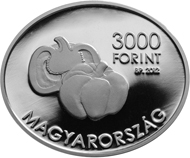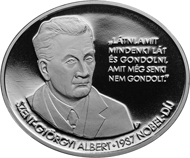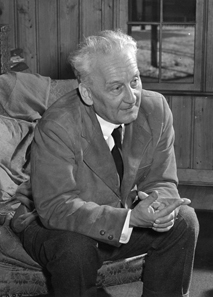December 20, 2012 – The fact that a country with a population of only 10 million has produced 13 Nobel Laureates, is worth celebrating and the National Bank of Hungary is taking that step with the launch of a new coin series dedicated to them. The first issue is dedicated to Albert Szent-Gyögyi, who won the Nobel Prize in Physiology or Medicine in 1937.
Hungary / 3,000 Forint / 925 silver / 12.5 g / 30 x 25 mm / Design: Fanni Vekony / Mintage: 2,000 (BU), 5,000 (Proof).
He was awarded the prize in recognition of his discovery of Vitamin-C. This is celebrated on the coin with the depiction of both the inside and outside of a pepper (in Hungarian “pritamin”), the vegetable from which Szent-Györgyi discovered he could extract the most Vitamin-C. The 3,000 forint coin is the creation of Fanni Vékony and is the first in the nation’s history to be oval in shape. It is made of .925 fine (sterling) silver, weighs 12.5 grams, and measures 30 x 25 millimeters. Just 2,000 pieces were authorized in brilliant uncirculated quality. Mirror-finish proof specimens, limited to a mintage of 5,000.
Portrait of Nobel Prize laureate Albert Szent-Györgyi, c.1948. Photo: J. W. McGuire / US National Institutes of Health.
Szent-Györgyi was born in 1893, and studied at the University of Budapest before serving in World War I on the Italian and Russian fronts. After completing his studies in Budapest, he worked and studied in Prague, Berlin, and Hamburg. In 1920 he became an assistant at the University Institute of Pharmacology in Leiden and from 1922 to 1926 Groningen, the Netherlands. In 1927 he went to Cambridge as a Rockefeller Fellow, and spent one year at the Mayo Foundation, Rochester, Minnesota, before returning to Cambridge. In 1930 he became the chair of Medical Chemistry at the University of Szeged and in 1935 he also assumed the chair in Organic Chemistry. When the Russians invaded Finland in 1939, he offered all of his Nobel prize money to the Finnish resistance.
When the Nazis came to Hungary, he joined the resistance, using his wealth to help Jewish friends flee. Even though Hungary aligned itself with the Nazis, the country’s prime minister wanted to conduct secret negotiations with the Allies so he sent Szent-Györgyi to conduct them. He scheduled a scientific talk in Cairo as a front, but the Nazis discovered the scheme and arrested him. Miraculously, he escaped and spent the rest of the war on the run, hiding from the Gestapo.
At the end of World War II, he took the chair of Medical Chemistry at Budapest and in 1947, upset with the rise of communism, he left Hungary to settle in the United States where he became Director of Research, Institute of Muscle Research, Woods Hole, Massachusetts. He died there in 1986.
You can read the Presentation Speech of Szent-Györgyi by Professor E. Hammarsten, member of the Staff of Professors of the Royal Caroline Institute, on December 10, 1937 on the official website of the Nobel Prize.
For more information visit the website of the Hungarian Mint.






